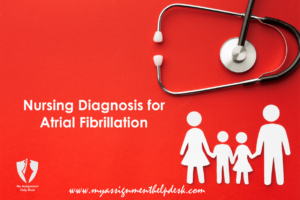Decreased Cardiac Output Care Plan
Decreased Cardiac output is one of the heart problems that affect a majority of heart patients. Decreased cardiac output is associated with the amount of blood that is pumped into the heart per minute. It is the product of the heart rate, which is the number of heartbeats for every minute, and the stroke volume. The standard cardiac output of a person ranges between 4 and 8 liters every minute, while a decreased output is less than 4 liters per minute.
After the diagnosis of the patient, the nurse should embark on a plan of care for the patient. The plan of care encompasses the intervention measures that help the patient’s heart to have improved heart activity. This article is a plan of care guide that a nurse can use to improve the quality of life of the patient with a decreased cardiac output care plan and aid in recovery.
Table of Contents
Plan of Care Goals and Outcome
Depending on the nature of the patient as well as the underlying cause of the cardiac problem, the expected outcome may vary. In this case, some patients could have their cardiac output get back to normal, while other chronic levels could necessitate management through a change in lifestyles. Some of the expected outcomes of the improved cardiac output include:
- Regaining the blood pressure to the normal range
- Pulse stability in the normal range of 60-100 beats per minute
- Breathing is not labored.
- The urine output is less than 30 ml per hour
- Improved recovery from fatigue
- Recovery from dizziness and confusion.
For patients with chronic case of decreased cardiac output, the interest is to ensure that the patient’s quality of life is maintained at a healthy level.
Care Plan
As part of the nursing care plan, the intervention may include treatment and monitoring of the patient’s condition. When the treatment is made through pharmacological and behavioral remedies, the nurse should also conduct continuous and regular monitoring of the patient to ensure that they are operating within normal limits.
Record Intake and Output
The nurse should make a record of the intake and output of the different parameters. First, the nurse should assess the urine output because decreased cardiac output is associated with a decline in the perfusion of the kidneys.
In addition, the patient should be assessed for the increased preload, the limits fluid, and sodium. It is also important to monitor fluid intake through the IV lines. In this case, it is appropriate that the nurse maintains a fluid restriction because, for patients with poorly functioning ventricles, they may not tolerate high fluid volumes.
Note Chest Pain
The nurse should also monitor the chest pains to determine the location of the pain, severity, and quality of the pain. It is a call for alarm if the chest pains are manifested through nausea. Chest pains are commonly associated with an inadequate supply of blood to the heart, thereby decreasing the cardiac output. It is imperative to note that for heart failure patients, chest pain is persistent for angina.
In instances where the chest pain is still high, the nurse should make the patient lie down and monitor the cardiac rhythm. Subsequently, the nurse should give oxygen and then run a strip before medicating for the pain. These actions increase oxygen delivery to the arteries and improve the patient’s diagnosis. It also gives room for the intervention of the physician while in a more stable state.
Blood Work
An essential part of the assessment is the determination of the level of elements in the blood that may have an impact on cardiac output. In light of this, it is necessary to conduct a laboratory examination on the arterial blood gases and levels of electrolytes such as potassium.
In addition, blood work is also conducted to determine the level of glycosides, which indicates the input of these elements. This is necessary because higher levels of glycosides are associated with hypokalemia.
Other laboratory tests that monitor the blood include sodium levels, serum, and creatinine. Routine blood work helps to give insights concerning the aetiology of heart failure as well as the extent of the decomposition. Some of the components in the blood, such as creatinine, are also associated with ACE inhibitors.
Administration of Medication
Part of the nursing plan is the administration of medication in line with the physician’s prescription while noting the side effects and the toxicity of the drugs. The nurse should ensure that the medication of the patient helps to maintain the cardiac output to normal.
Depending on the etiological factors, the medication encompasses digitalis therapy, vasodilator therapy, angiotensin-converting enzyme (ACE) inhibitors, as well as inotropic agents.
Some of the medications are to improve cardiac functions while others address the symptoms exhibited by the patient. Other medications include stool softeners because the decreased activity is associated with constipation. If left untreated, it may lead to straining during defection and probably dysrhythmia, which may cause death.
Monitoring of Blood pressure
The nurse should also monitor the blood pressure and pulse condition before administering ACE, carvedilol, and beta-blockers. The nurse should also notify the physician of the heart rate and blood pressure, if low before holding any medications.
The nursing evidenced practice has recommended that nurses should assess the patient’s level of tolerance before giving the medications. In the care plan, continued consultation with the physician is necessary as they may decide on whether to have medication put on hold or be administered even when the blood pressure is lower.
What’s more?
As part of the nursing care, the patient should have a heart failure rehabilitation program. The cardiac rehabilitation program may encompass education, evaluation, and provision of support to increase activity as well as rebuild the quality of life. Besides, the program should also encompass a monitored exercise program that is geared toward improving functional capacity as well as left ventricular function.
Family members also play a noble role in the patient’s recovery process. As such, the nurse should engage on a teaching program to impact the family members on the different ways of taking care of the patient. Some of the tricks include observation of symptoms, the importance of smoking cessation, information on medication, and adoption of life changes to maintain an improved patient’s cardiac functioning.
References
American Heart Association (AHA). (2013). Heart disease and stroke statistics—2013 update. Circulation, 127(1), e6–e245. Retrieved from http://circ.ahajournals.org/ content/127/1/e6.full.pdf+html?sid=4c0e1444-d592- 434d-b2a0-d72abdb6a2ec
DeWit, S. C., Stromberg, H., & Dallred, C. (2016). Medical-surgical nursing: Concepts & practice. Missouri: Elsevier Health Sciences.
Hodges, P. (2009). Heart failure: Epidemiologic update. Critical Care Nursing Quarterly, 32(1), 24–32
Kee, J. L. (2014). Laboratory and diagnostic tests with nursing implications (9th ed.). Boston, MA: Pearson
Pere, K. (2012). Developing nursing expertise in caring for older advanced-stage heart failure patients and their families—palliative and end-of-life care. Canadian Journal of Cardiovascular Nursing, 22(3), 12–17.
Perrin, K. O., & MacLeod, C. E. (2012). Understanding the Essentials of critical care nursing (2nd ed.). Upper Saddle River, NJ: Pearson Prentice Hall.






Pingback: Ineffective Breathing Pattern Care Plan | Care plan for difficulty of breathing